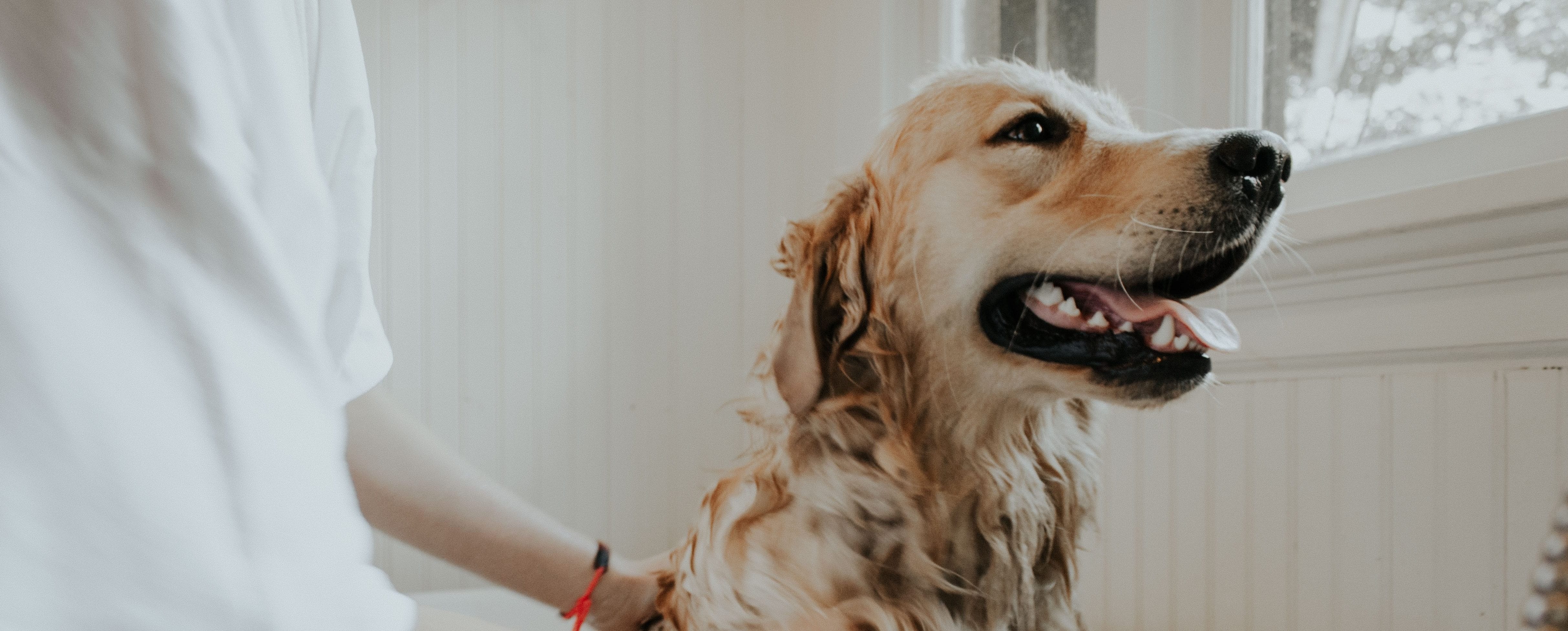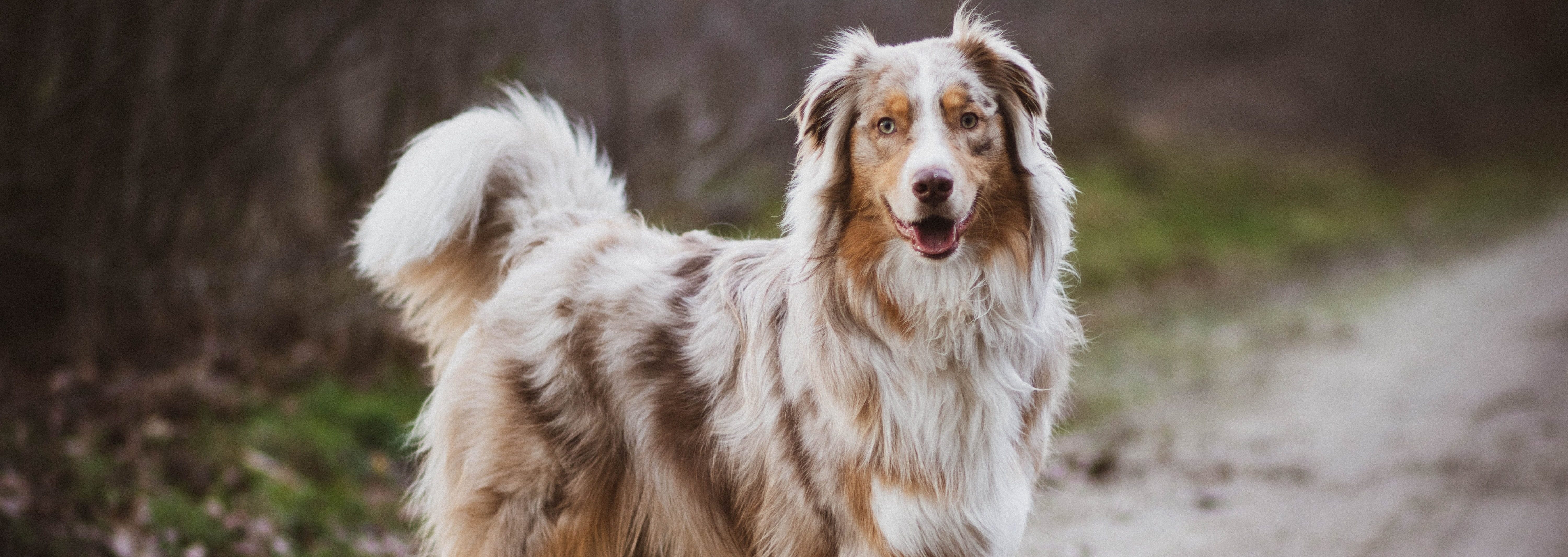Underneath your dog’s healthy coat, whether it is a full and luscious mane or a short and bristly pelt, is a whole lot of skin. And what’s more, a dog’s skin is very sensitive, which is why it’s so important to use the right pet shampoo. When it comes to canine skin care, we may be dismissive at times, or even downright forgetful because of how little skin is exposed on our dogs. However, dogs are susceptible to skin problems, and below are the top 5 common dog skin problems you could encounter as a dog owner.
Hair Loss
For the most part, hair loss in dogs is the symptom of a more severe skin issue rather than the underlying cause. When you begin to notice your dog losing hair, it is important to pay close attention to whether the hair is falling out on its own or if your dog is chewing it off as the result of irritated skin underneath the fur. If the hair is falling out on its own, then it may be one of the following skin conditions that are the impetus for the hair loss.
Causes
The two leading skin conditions that cause hair loss in dogs are pressure sores and parasite infestation. Pressure sores are more prevalent in older dogs but can manifest themselves at any age depending on your dog’s predisposition to them. Parasite infestations occur as a result of contact with a particular parasite or bug, and an infestation occurs when the contact goes unnoticed or untreated. Most often, parasite infestations come in the form of fleas, ticks, and occasionally, ringworm. Dogs tend to pick these critters up from parks, wooded areas, and even other dogs.
Signs and Symptoms
Pressure sores can be identified by hard scabs and scaly skin tissue in and around the joints, and an infestation can be identified by vigorous gnawing or scratching at the affected area. Both of these skin conditions are characterized by hair loss. While the cause of hair loss is slightly different for each, in both situations, the hair falls out as a direct result of skin irritation. Whether from pressure or parasitic infestation, when your dog’s skin becomes irritated, it begins to scab over. As this happens, the hair will not be able to grow in the affected areas, and it will start to fall out. Look for bald spots or patches of thin hair as signs that your dog’s skin may be under attack from an external source.

Treatments
The treatments for pressure sores is two-fold and includes treatments like topical creams to soothe the affected areas, as well as introducing padded surfaces like a dog bed to allow your dog a more comfortable surface with less abrasive pressure. Bug and parasite infestations are often treated with a combination of topical antifungals and in some cases more intense chemicals to kill and eradicate the pests from your dog’s skin. Be sure to speak to and work with your vet to develop a treatment plan best suited for your dog.
Hot Spots and Dandruff
Hot spots are also called moist dermatitis and can be categorized as wet open sores on your dog’s skin. A related skin issue to hotspots is dandruff, where instead of the surface being irritated by too much moisture, it is caused by a lack of moisture turning the skin scaly and flaky.
Causes
Hot spots come as the result of excessive licking or scratching, and sometimes as a combination of both. Much like hair loss, hot spots are often the result of a different more deep seeded skin issue that causes your dog to attempt to lick and scratch the irritation into submission. This irritation could be the result of something as simple as a flea bite or a thorn that is stuck between the skin and fur.
Dandruff is caused by a lack of moisture in the skin, and often if your dog suffers from dandruff, hot spots are soon to follow. As your dog deals with the dry and flaky irritation of dandruff, it will try to compensate by licking and scratching at the surface of the skin. This inevitably causes more serious skin issues like hot spots to wreak havoc on the skin.
Signs and Symptoms
Dandruff is an easily noticeable skin condition. As the skin dries out and becomes flaky and scaly due to dandruff, small particles of skin, usually white in color, will flake off and either stick in your dog’s fur or fall to the ground. Hot spots are a type of infection and often cannot be seen underneath the coat. Some signs your dog may be experiencing a hot spot include excessive licking, itching, and guarding the surrounding area. If you suspect that your dog is suffering from a hot spot, separate the fur and inspect for an open wet sore.
Treatments
Dandruff is not curable, it is, however, treatable and relatively easy to keep in check. Because dandruff comes on as the result of dry skin, introducing more fatty acids into your dog’s diet and using a conditioning dog shampoo will both help in keeping dandruff in check by adding moisture to your dog’s skin.
Hot spots should be treated by shaving away the fur around the lesion and applying a topical treatment daily to kill bacteria and prevent further growth. Be sure to keep the area clean and allow it to heal on its own. To prevent your dog from messing with the hot spot and making it worse, you may want to consider using a cone.
Allergic Dermatitis
Allergic dermatitis simply means an allergic reaction manifested in the skin. This skin condition can be brought on by any number of external triggers that cause a dog’s immune system to overreact with a physical response. Allergies in dogs are quite common and typically fall into the categories of contact allergies, inhalant allergies, and ingested allergies.
Causes
Brought on by a myriad of sources, allergic dermatitis is most commonly caused by pollen, food, and direct skin contact with foreign bodies like flea saliva or harsh chemicals. Dogs can inherit allergies from their parents, as a predisposition to specific allergens can be passed down through genetic material. Allergic dermatitis occurs when an allergen is exposed to the immune system over a long period. Eventually, the immune system mislabels a particular allergen, like pollen, as a threat to the immune system, which triggers the immune response of an allergic reaction.
It is an owner’s responsibility to account for changes in environment like seasonal blooms, the introduction of new chemicals like fertilizers, or changes in diet as these could all trigger an allergic reaction from your dog. The most common allergens that a dog is susceptible to developing an aversion to are:
- Heat
- Grass
- Pollen
- Dust Mites
- Mold Spores
- Food
- Bug Bites

Symptoms of allergic dermatitis include:
- Itching
- Excessive licking – especially in the paws and feet
- Itchy ears – shaking his head back and forth
- Biting, gnawing at the skin
- Excessive chewing
- Hair Loss
- Red, inflamed skin
- Visible rashes
- Hives and other bumps
- Swollen face and paws
Treatments
Be sure to monitor any strange behavior your dog may be exhibiting in conjunction with the symptoms listed above as they may indicate an allergic response. As with any condition or irritation your dog may be suffering from, it is crucial that you allow your vet to make the official diagnosis regarding your dog’s condition and a compatible treatment plan.
Rashes and Hives
Rashes, and more specifically hives, are an extension of the allergic dermatitis family with one crucial distinction. While allergic dermatitis is caused by the immune system’s introduction to an allergen over time, rashes and hives are an involuntary rapid onset reaction to a specific stimulus.
Causes
For the most part, rashes and hives are the result of a contact allergy. Typically to produce hives, the skin must come in direct contact with an allergen. There are cases where hives are the result of ingesting or inhaling an allergen, but for the most part, direct dermis contact will spur a rash or hives. Potential causes for hives and other rashes include bug bites, poisonous plants, pesticides, and fertilizer.
Signs and Symptoms
Hives can appear anywhere on your dog’s body but are most prevalent on the abdomen, face, and legs. Rashes will tend to be red in color and generally carry with them some kind of texture. In the case of hives, look for patches little red bumps that are clumped together. Hives are a specific rash that include additional symptoms such as swelling of the jowls, redness around the ears, excessive drooling and swollen face and eyes. Hives may not always be visible, and they sometimes hide in your dog’s ears.
Treatments
Rashes can be treated the same way most skin issues are dealt with by administering a topical cream. Remember to never give your dog anything without having the substance approved by your veterinarian. Due to the rapid onset of hives and most other rashes, typically a remedy for the ailment is case specific.

Skin Infections
Infection is one of the most common forms of dog skin problems. Due to the wide variety of skin infections that are possible for a dog, it is vital that you consult your veterinarian before attempting to diagnose your dog yourself. Bacterial infections are often treatable and usually no cause for alarm. When the skin becomes infected, it is referred to as pyoderma and is the general term used to describe any type of infection on the skin.
Causes
Pyoderma is any disruption of the skin due to bacteria, fungi, or other microbial agents that cause infection. Most commonly, infections occur when a wound goes untreated, but infections can also take root in healthy, undamaged skin. The most common types of skin infections for dogs include yeast infections, impetigo, and ringworm. Impetigo and yeast infections are both bacterial in nature, while ringworm is caused by fungal overgrowth.
Signs and Symptoms
Depending on the specific infection, symptoms will vary. However, there are a few tell-tale signs that usually point to infection of some kind. First, skin infections will typically include some sort of pus-filled scabs or red bumps on the surface of the skin, also known as pustules and lesions. In the case of impetigo, pus-filled bumps will appear on the abdomen and the paws. Second, infections will typically turn the skin a discolored mix of red, orange, yellow, and brown and include some kind of dried discharge. In the case of yeast infections, you will notice a thick coating of yellowy discharge in between the toes on your dog’s paws and in the ear flaps. Finally, infections will generally make the skin hard and crusty, which will cause old hair to fall out and prevent new hair from growing. This loss of hair, known as alopecia, is a good indicator that your dog may be suffering from some kind of infection.
Treatments
Treatments for infection are case specific and vary in intensity depending on the severity of the infection. Typically vets will prescribe a tandem approach of topical and systemic therapy such as antibiotics. Traditionally infections are treated for a few weeks and monitored to prevent any further issues in your dog’s health.
Wrapping Up
With all the activity your dog gets into, there is a good chance that at some point, your dog will have a problem with his skin. However, with the right knowledge and a willingness to take the proper action, you can keep your dog’s skin healthy all summer long! Skin problems in dogs can be manageable but often require long-term or even lifelong treatment. Be sure to act quickly when you notice a potential problem with your dog’s skin and always consult a vet for a professional diagnosis.
Sources:
https://www.caninejournal.com/dog-skin-problems/
https://pets.webmd.com/dogs/ss/slideshow-skin-problems-in-dogs
https://www.petmd.com/dog/centers/nutrition/evr_dg_common-dog-skin-problems
https://www.hillspet.com/dog-care/healthcare/5-common-dog-skin-problems
https://www.1800petmeds.com/education/pet-medications-common-skin-problems-9.htm
https://www.aspcapetinsurance.com/blog/2016/february/22/common-skin-problems-in-dogs/
 Dr. Melinda J. Mayfield-Davis, DVM, WCHP-AH, brings over 20 years of experience in veterinary medicine. She is the Technical Services Veterinarian with Innovacyn, Inc., parent company of Vetericyn Animal Wellness. She received her DVM from Oklahoma State University and now resides in Southeast Kansas with her husband, two children, four dogs, and six horses. Prior to working with Innovacyn, Dr. Mayfield owned and operated the Animal Care Center in Columbus, KS.
Dr. Melinda J. Mayfield-Davis, DVM, WCHP-AH, brings over 20 years of experience in veterinary medicine. She is the Technical Services Veterinarian with Innovacyn, Inc., parent company of Vetericyn Animal Wellness. She received her DVM from Oklahoma State University and now resides in Southeast Kansas with her husband, two children, four dogs, and six horses. Prior to working with Innovacyn, Dr. Mayfield owned and operated the Animal Care Center in Columbus, KS.


